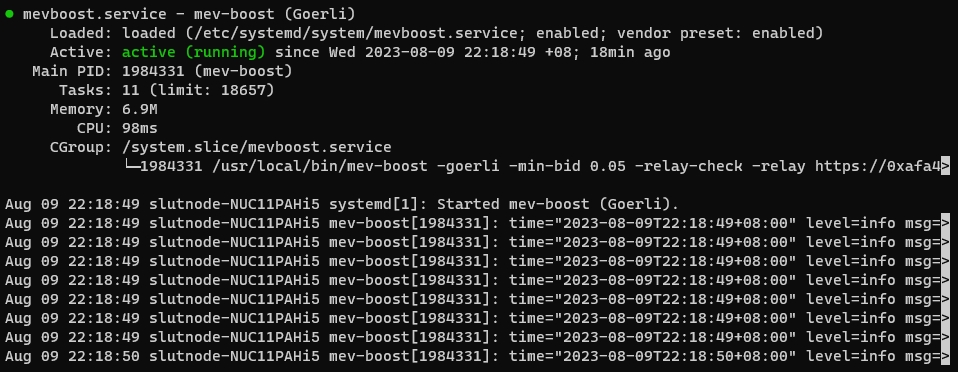Set up and configure MEV-boost
Install and configure MEV-boost
Install dependencies - Make, Git
sudo apt install make gitInstall dependencies - Go (download page here) - and make sure the latest version (1.22.0) is output at the end of this command batch.
curl -LO https://go.dev/dl/go1.22.0.linux-amd64.tar.gz
echo "f6c8a87aa03b92c4b0bf3d558e28ea03006eb29db78917daec5cfb6ec1046265 go1.22.0.linux-amd64.tar.gz" sha256sum --check
sudo tar xvf go1.22.0.linux-amd64.tar.gz -C /usr/local
export PATH=$PATH:/usr/local/go/bin
echo "export PATH=$PATH:/usr/local/go/bin"
go versionDownload latest version of MEV-boost.
cd
git clone https://github.com/flashbots/mev-boost.git
cd mev-boost
git checkout tags/v1.7-alpha1Build the executable file.
make buildCopy the executable file to the /usr/local/bin folder.
sudo cp mev-boost /usr/local/binDownload latest version of MEV-boost here and run the checksum verification process to ensure that the downloaded file has not been tampered with. The checksums can be found in the checksums.txt file - open it up and copy the linux_amd64 version to use below.
cd
curl -LO https://github.com/flashbots/mev-boost/releases/download/v1.8/mev-boost_1.8_linux_amd64.tar.gz
echo "18b8af03787a0a57557ab8f8c483fe5143d81208b28f813fd93ad256ad52e5db mev-boost_1.8_linux_amd64.tar.gz" | sha256sum --checkExpected output: Verify output of the checksum verification
mev-boost_1.8_linux_amd64.tar.gz: OkIf checksum is verified, extract the files and move them into the (/usr/local/bin) directory for neatness and best practice. Then, clean up the duplicated copies.
tar xvf mev-boost_1.8_linux_amd64.tar.gz
sudo cp mev-boost /usr/local/bin
rm mev-boost* LICENSE README.mdCreate an account (mevboost) without server access for MEV Boost to run as a background service. This restricts potential attackers to only the MEV Boost service in the unlikely event that they manage to infiltrate via a compromised client update.
Create a systemd configuration file for the tekubeacon service to run in the background.
Paste the configuration parameters below into the file:
Once you're done, save with Ctrl+O and Enter, then exit with Ctrl+X. Understand and review your configuration summary (flags) below, and amend if needed.
MEV Boost configuration summary:
-holesky: Run the MEV-boost service on the Holesky testnet-min-bid: Set the threshold to accept blocks from relays if they bid above a chosen value, otherwise propose a locally-built block. This sacrifices a small ~0.1% APR in exchange for much better censorship resistance, allowing you to use OFAC-compliant relays guilt-free! More information here-relay-check: check relay status on startup and on the status API call-relay: A chosen relay URL. Choose your preferred ones here - https://github.com/eth-educators/ethstaker-guides/blob/main/MEV-relay-list.md
Start the MEV Boost service
Reload the systemd daemon to register the changes made, start MEV Boost, and check its status to make sure its running.
Expected output: The output should say MEV Boost is “active (running)”. Press CTRL-C to exit and MEV Boost will continue to run.

Use the following command to check the logs for any warnings or errors:
Expected output:
Press CTRL-C to exit.
If the MEV Boost service is running smoothly, we can now enable it to fire up automatically when rebooting the system.
Last updated